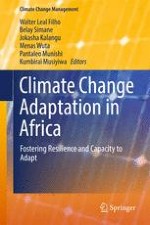This collection showcases experiences from research and field projects in climate change adaptation on the African continent. It includes a set of papers presented at a symposium held in Addis Abeba in February 2016, which brought together international experts to discuss “fostering African resilience and capacity to adapt.” The papers introduce a wide range of methodological approaches and practical case studies to show how climate change adaptation can be implemented in regions and countries across the continent. Responding to the need for more cross-sectoral interaction among the various stakeholders working in the field of climate change adaptation, the book fosters the exchange of information on best practices across the African continent.
